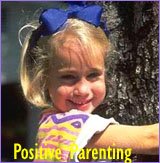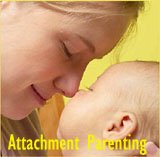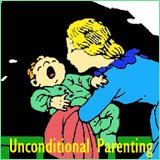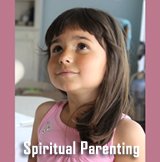A Biography of John Bowlby:
The Father of Attachment Theory
- Read the brief and engaging biography of
psychologist, psychiatrist and psychoanalyst John Bowlby!
- See how separation issues in his own childhood may
have influenced his choice of career and fuelled his passion for
developing his famous
attachment theory
- Follow his academic journey through the
psychoanalytic battle zone!
The Strict British Morals of John's Childhood: 'You Can See Your Mom after Teatime!
In 1907 John Bowlby was born into a typical British
upper-middle-class family. (He was child number four - later two
more siblings joined the family, which then made a total of six
kids).
Being born into a firm web of early twentieth century
British traditions meant that there were certain strict beliefs in
relation to child rearing, child discipline and child parent
relationships:
- A child was raised to be 'strong' and hardened via strict
child discipline.
- Signs of emotional affection between parent and child were
generally not encouraged.
- Emotions were mainly seen as a sign of weakness, and affection as spoiling.
Also the daily care of children wasn't the job of a British
upper-middle-class mom. No, it was the job of a nanny.
Thus
Bowlby was raised by a nanny, too. Supposedly he only saw his mother
only once a day after 'teatime' for about an hour.
His
father - who worked as a surgeon - he saw even less ... apparently
only on Sundays.
John's Early Loss of His Beloved Nanny
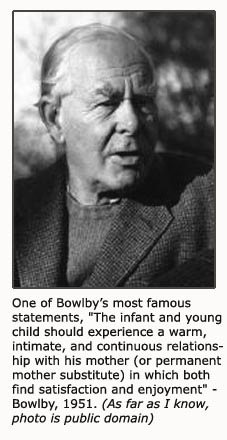 Because children of that time spent so much time with their nannies,
they often developed a deep emotional attachment to them. If the
nanny was likeable, the child would often form a bond to her that
would resemble that which exists between a child and his or her
mother today.
Because children of that time spent so much time with their nannies,
they often developed a deep emotional attachment to them. If the
nanny was likeable, the child would often form a bond to her that
would resemble that which exists between a child and his or her
mother today.
John Bowlby allegedly loved his nanny very much but sources disagree
as to whether she
was there throughout his childhood or
whether she left his family when he was about four years old.
The source claiming the latter version describes this
happening as a tragic event in John Bowlby's early life - something
that made a deep and lasting impression on him.
Later he
allegedly commented on this early separation, saying that the
severing of this bond to his nanny had felt like the loss of a
mother.
Perhaps this traumatic event was the driving force
behind Bowlby's academic passion for studying the psychology of
children: particularly child suffering because of maternal
deprivation, which gradually led to his theoretical establishment of
attachment theory.
7 Years Old: 'Off to Boarding School You Go!'
Once again being born into the 'better' British social class
entailed following certain societal traditions.
When Bowlby
was about seven years old, he was sent off to stay at a boarding
school.
Like so many other famous writers, he describes his
boarding school experience (especially the early part) as being
downright terrible and possibly traumatic:
He later said:
'I wouldn't send a dog away to boarding school at age seven'.
Once again, we possibly have more personal fuel for attachment
theory and his later interest in institutionalized children and
child grief caused by stressful separation from primary caregivers.
As you will read farther down, Bowlby did an extensive study
of institutionalized children in hospitals.
His Teenage Years: A Quick Dive into the Navy
From boarding school, he decided to attend the Royal Naval College,
Dartmouth. This decision only lasted until he was 17.
Following Dad's Footsteps into Medicine ... But Psychology Seemed More Alluring
John Bowlby then decided to follow in his father's medical footsteps
to Trinity College, Cambridge, to study medicine. He graduated from
there in 1928.
However, three years into this medical study,
he was drawn to what is today developmental psychology.
John Sets His Medical Career on Hold to Study Maladjusted Children
When Bowlby finished his medical training and degree, he
decided to do volunteer work at a school with 24 'maladjusted'
children.
At this school especially two boys made a deep
impression on him. He was emotionally moved and intellectually
intrigued by their rough childhood history and early relationship
challenges: one of the boys had grown up with no primary caregiver
figure.
Bowlby's friend and colleague John Alford another
volunteer at the school, persuaded Bowlby to go back to school
and study child psychiatry and psychoanalysis. Doing such a study
into the psychology of children would develop his thoughts on the
caregiver's influence on early child development, John Alford argued.
At that time, it was unheard of that a child's psychological
development was to be affected by early child parent relationships.
That
close attachment to a primary caregiver might be crucial for
the child's well-being and positive psychological growth
was seen as very provocative in academic circles.
John Is Back in School and Takes His First Step into the Psychoanalytic Circle
John Bowlby did not at all feel like going back to school to do
medical training to gain further access to studying.
Fortunately rigorous training wasn't necessary as he was easily
accepted into the British Psychoanalytic Society.
John Bowlby, the Black Sheep: Breaking with the Kleinian Fantasy Focus of Psychoanalysis
While studying psychiatry, John Bowlby also received psychoanalytic
training at the British Psychoanalytic Institute.
Here
Bowlby met with Melanie Klein, whose theoretical views had a major
influence on psychoanalytic thought at the time.
However,
Bowlby found her psychoanalytic approach to child psychoanalysis
wrong and limited.
He thought that rather than focusing on
the conflicts in a child's inner fantasy world, analysts ought to
pay more attention to actual events that happened in early childhood
- real relationships:
For instance the mechanisms
and long-term consequences of early child separation from primary
caregivers.
John Bowlby Takes over the Children's Department of the Tavistock Clinic
After having done service in the Second World War, Bowlby returned
to become head of the Children's Department of the Tavistock Clinic.
To emphasize his focus on relationships rather than inner
fantasy world, he changed the name of the clinic to Department for
Children and Parents.
Because of Bowlby's radical views: his
empirical interest in what actually happens in childhood as a
precursor for healthy or unhealthy development, it was difficult for
him to assemble a research team.
Most people were still in
favour of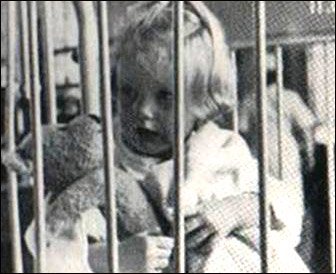 the Kleinian focus on the inner fantasy world.
the Kleinian focus on the inner fantasy world.
However, in 1948, he hired James Robertson to do research into the
effects of periodic child parent separation and child grief among
young hospitalized children.
This two year research project
made such a moving impression on both of them that they felt
compelled to do a film "A Two-Year-Old Goes to Hospital".
This film stirred up so many people's emotions that it
forever changed hospital policies for visiting hours, among other
things.
Also it had major impact on what was to become
attachment theory.
Mary Ainsworth Joins Forces with John Bowlby
In 1950
Mary Ainsworth joined the research team.
Mary Ainsworth was very impressed with the observational methods
that Robertson had used during his fieldwork in hospitals.
She allegedly said that she would 'take them with her' when she
would do her own studies.
This she actually did a little
more a decade later when she invented the famous lab experiment: The
Strange Situation Protocol.
The result of this Strange
Situation Experiment and later research was an elaboration of
attachment theory suggesting that an infant may show one of
four attachment styles towards his or her
primary caregiver (typically his or her mother).
John Bowlby Gives 'Formal Birth' to Attachment Theory
Event though attachment theory had been present in Bowlby's way of
thinking for a long time, it was only in 1957 that he formally
presented his ideas to his very critical audience.
In the
ethologically inspired paper, 'The Nature of the Child's Tie to
his Mother', Bowlby caused quite a stir within the
Psychoanalytic Society as he critically opposed the current line of
psychoanalytic thinking.
Next, Unstoppable John Bowlby Presents 3 Steps of the Separation Process
The criticism of his thoughts didn't stop the direction of his
thoughts on attachment theory and the psychology of children.
In 1959 Bowlby presented a 3 step process that a child may go
through when experiencing traumatic separation from a close
caregiver:
- protest
- despair
- detachment / denial
Bowlby Makes New Provocative Theories About Child Mourning
Up to now the prevailing concepts about child grief were put forward
by well-respected Anna Freud and Melanie Klein.
Anna Freud
claimed that an infant couldn't grieve for more than instants at a
time because of the undeveloped nature of the infant's mind (in
Freudian language: the lack of ego).
Melanie Klein claimed
that the biggest trauma in a baby's life was the weaning from the
mother's breast.
Bowlby, however, introduced the concept that
separation behavior would occur when a baby or
child experienced a stressful separation from his / her mother, and
that grief would occur if the mother continued to be absent or gone.
This cutting edge theory was explained in his "Grief and
Mourning in Infancy and Early Childhood" from 1960.
Bowlby Further Develops Attachment Theory Supported by Mary Ainsworth's Data
Despite the psychoanalysts' rejection of his theories, Bowlby
continued to study his view of attachment theory.
With the
empirical assistance from Mary Ainsworth's study of infant
attachment behavior, in 1969 he published the first volume: 'Attachment'
of the trilogy 'Attachment and Loss'.
In 1972, the
second volume: 'Separation: Anxiety and Anger' and the
third volume: 'Loss: Sadness and Depression' saw the light
of day.
John Bowlby Finally Gains Ground in the 1980s
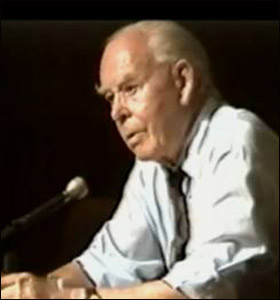 Despite constant rejection from the prominent psychoanalytic circle,
John Bowlby's attachment theory became much more appreciated in the
1980s, when it was the source of inspiration of many attachment
research articles and therapies.
Despite constant rejection from the prominent psychoanalytic circle,
John Bowlby's attachment theory became much more appreciated in the
1980s, when it was the source of inspiration of many attachment
research articles and therapies.
Some Last Words from Bowlby
Bowlby had four children with his wife, Ursula Longstaff, who
he married in 1938.
Bowlby passed away in 1990.
Some
of John Bowlby's last written words nicely encapsulate his focus on
attachment in close relationships:
- "Many of the most intense emotions arise during the
formation, the maintenance, the disruption and the renewal of
attachment relationships.
The formation of a bond is described as falling in love, maintaining a bond as loving someone, and losing a partner as grieving over someone.
Similarly, threat of loss arouses anxiety and actual loss gives rise to sorrow; while each of these situations is likely to arouse anger.
The unchallenged maintenance of a bond is experienced as a source of security and the renewal of a bond as a source of joy" (Bowlby 1991).
If you want to see Bowlby speak a little about the importance of close attachment and motherly bonds, see the video below.
Other Research-Based Articles on Bowlby
If you want more biographical knowledge about Bowlby, you might like to visit one of these places:
- John Bowlby
(Wikipedia)
-
The Origins of Attachment Theory: John Bowlby and Mary Ainsworth
- The Bowlby Centre: Promoting Attachment and Inclusion
If you want research-based articles on attachment theory, just scroll further down to the links at the end of this article:-)
Your Positive Parenting Ally,
Birgitte

Want to stay in touch and get the latest news?
Sign up
for my free newsletter
Parent Coaching
- For Inner Peace, Clarity and a Deeper Connection to Your Child
 Being a parent can feel like a double-edged sword. Life with kids may feel like the greatest gift you have ever received, while at the same being hugely challenging, often leaving you confused, stressed and overwhelmed.
Being a parent can feel like a double-edged sword. Life with kids may feel like the greatest gift you have ever received, while at the same being hugely challenging, often leaving you confused, stressed and overwhelmed.
When we feel like this, we've lost touch with ourselves. We can't hear our own inner voice, and it's difficult to know what is 'right' for us and how to act.
I offer in-depth parent coaching to help you regain your balance and get back in touch with yourself. From a place of inner peace and clarity, your will find your own answers which will help you reconnect with your child from a place of unconditional love and acceptance.
Read more about my parent coaching here.
Where Would You Like to Go Next?
Attachment Parenting Articles
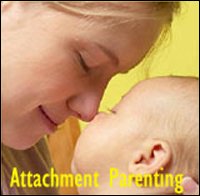 Attachment Parenting and Intuitive Parenting: Read Your Child Rather Than Some Book! |
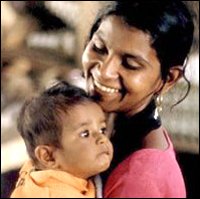 What Is Attachment Parenting? 10 Sharp Truths and 2 Common Misconceptions! |
Attachment Theory Articles (Scientific Angle)
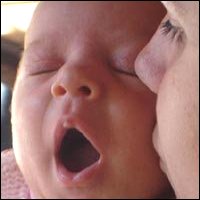 Psychology Attachment Behavior; Find out When to Expect the Constant Clinging or the Letting Go of Mom's Skirt! |
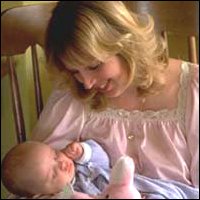 Attachment Theory is Good Basic Knowledge ... But Misses Out on Individual Infant Temperaments! |
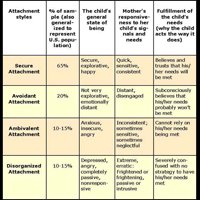 The Four Infant Attachment Styles: Straight to the Point, Quick Understanding! |
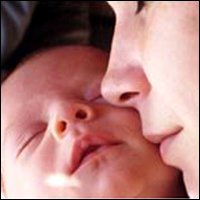 Secure or Insecure Attachment in Infancy ... Largely Shapes Who We Are Today! |
Attachment Experts
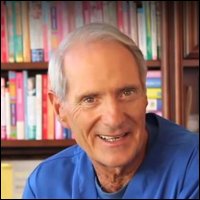 Deep Insights into the Essence Dr Sears' Attachment Parenting along with a Fascinating Historical View on the Slow Rising Consciousness of Attachment Parenting |
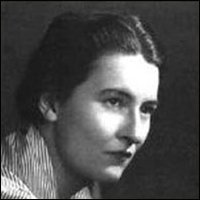 Mary Ainsworth: The Refiner of Attachment Theory |
Attachment, High Need and Separation Anxiety
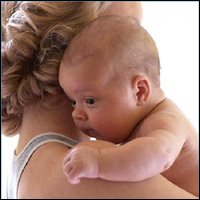 A High Need Baby: A Strong Personality Is Great, But Where's the Off Button? |
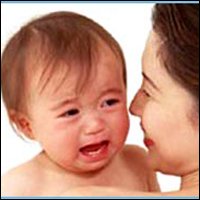 Baby Separation Anxiety The More Your Baby Clings, the More You Let Him! 10 Tips to Ease Baby Separation Anxiety |
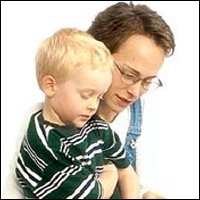 Valuable Insights into Separation Anxiety in Children and Babies: Meet Your Child with Full Acceptance and Deep Connection! |
 Facts and Fiction about the Controversial Ferber Method along with a Discussion of Its Potential Long Term Consequences |
Back to the top of this page about A Biography of John Bowlby: The Father of Attachment Theory
Go to the Positive Parenting Ally Homepage




